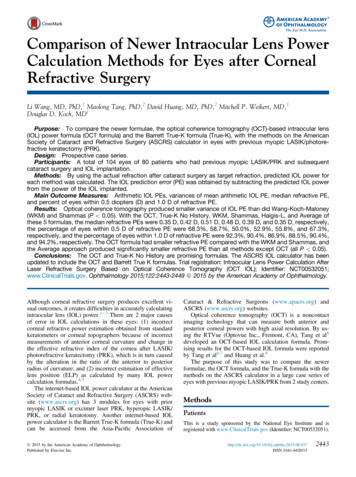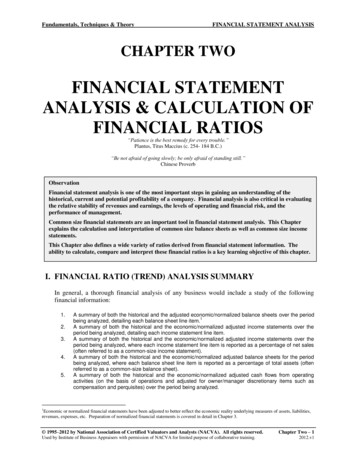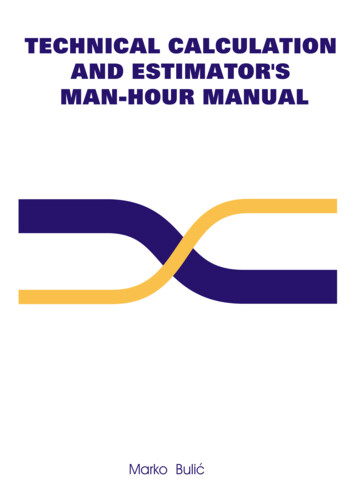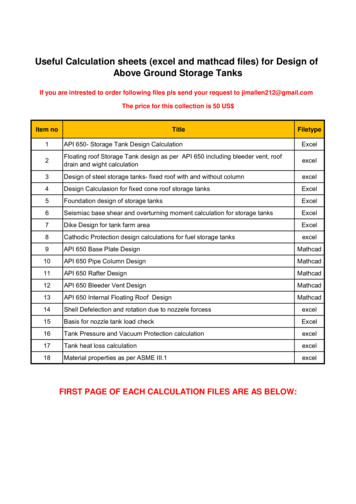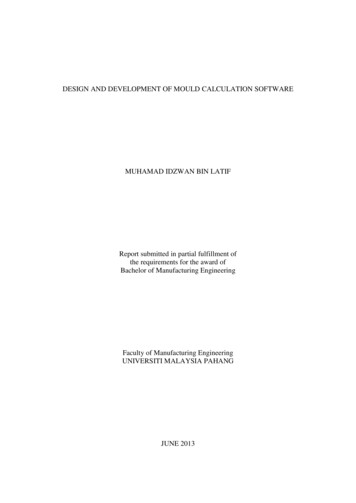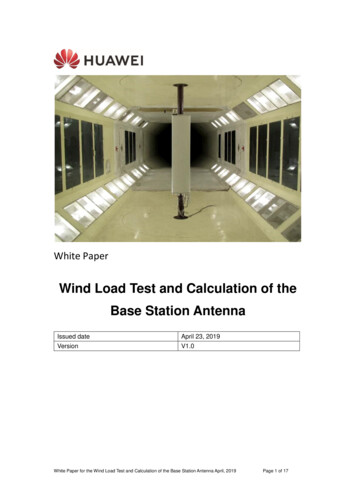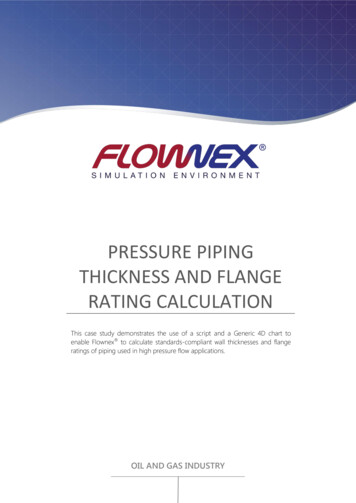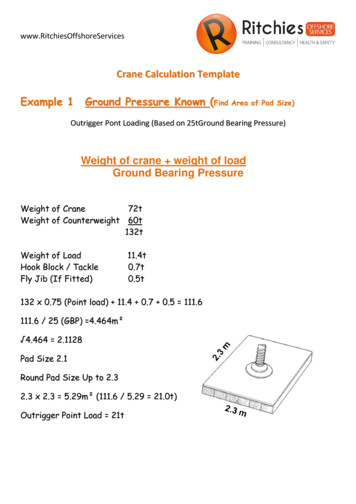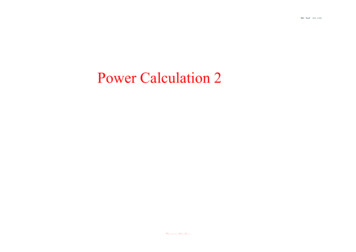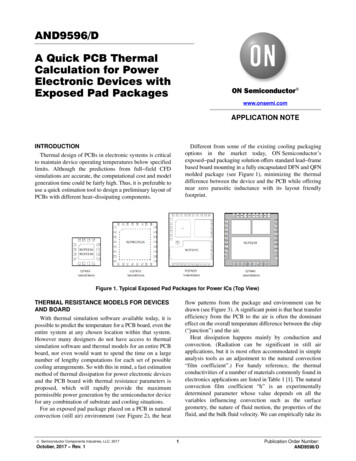
Transcription
A publication ofAIDIC CONFERENCE SERIESVOL. 11, 2013Chief Editor: Sauro PierucciCopyright 2013, AIDIC Servizi S.r.l.,ISBN 978-88-95608-55-6; ISSN 2036-5969The Italian Associationof Chemical Engineeringwww.aidic.it/acosDOI: 10.3303/ACOS1311009Analysis and Comparison of Calculation Methods for PhysicalExplosions of Compressed GasesRoberto Bubbico, Barbara MazzarottaDipartimento di Ingegneria Chimica Materiali Ambiente, “Sapienza” Università di Roma, Via Eudossiana 18, 00184 Romabarbara.mazzarotta@uniroma1.itDue to the complexity of the involved physical phenomena and to the lack of an adequate amount of reliableexperimental data, a number of different models and calculation procedures for estimating the overpressurefollowing the physical explosion of a compressed gas are presently reported in the literature. However, in manycases, only generic information about the main hypotheses adopted is provided and no guidelines about theiraccuracy, or range of applicability, are usually available.In the present paper the physical explosion of a compressed gas, released after the catastrophic rupture of itscontainment system, is addressed. The analysis is carried out by means of two of the most commonly usedcalculation procedures, which have been applied to a number of study cases, characterized by differentsubstances, volume, geometrical configuration, and operating conditions.The obtained results are presented and compared. The analysis shows that, in all cases, the two methods giverise to different results, independently of the involved chemical, vessel size, and operating conditions. Thedependence of the results on the main input parameters is highlighted in order to give a preliminary guideline inthe selection of the proper calculation method for each specific study case.1. IntroductionDifferent models and calculation procedures are presently available in the literature for estimating the peakoverpressure and the other parameters of interest following the sudden explosion (expansion) of a compressedgas in air. This derives from the complexity of the physical phenomenon, the high number of parameters involved,the variability of the real geometrical configuration and of the physical conditions before the explosion, and so on.As a consequence, different simplifying hypotheses are often adopted, thus introducing some approximation anduncertainty of the results. Furthermore, in the field of risk analysis, a compromise is generally required betweenthe accuracy of the models and their ease of use. This is often preferred, with respect to the use of a much morecomplex model, for the sake of simplicity and rapidity of application when a large number of simulations have tobe carried out, or when a preliminary analysis of the system (a plant, activity, etc.) is only required.In the following, the two probably most common models used in risk analysis to predict the pressure profilesgenerated by a gas explosion are adopted for estimating the overpressure profiles for a number of referenceexplosion scenarios. Their basic assumptions and calculation steps will be briefly recalled, while in thesubsequent sections their results will be compared and critically discussed.1.1 Baker’s methodBaker et al. (1983) have developed a method for modeling pressure vessel bursts, either for ideal and non-idealgases. Different versions of this model are reported in the literature (AIChE/CCPS, 1994; AIChE/CCPS, 1999) butthe basic one will be adopted here.In the Baker’s method far and close range are treated differently; the energy of explosion is calculated by meansof the Brode equation (Brode, 1959):Please cite this article as: Bubbico R., Mazzarotta B., 2013, Analysis and comparison of calculation methods for physical explosions ofcompressed gases, AIDIC Conference Series, 11, 81-90 DOI: 10.3303/ACOS131100981
E (P1 P0 )V(1)γ 1where:E energy (J);P1 initial pressure of the expanding gas (Pa);P0 final (ambient) pressures of the expanding gas (Pa);3V gas total volume (m );γ gas heat capacity ratio, Cp/Cv (-).When the explosion occurs at ground level, the calculated value of the energy is generally multiplied by 2 to takeinto consideration ground effects, like the reflection of the shock wave, even if this is just an approximation, whichdoes not properly represent the complexity of a real explosion.The pressure profile is then obtained by using the Sachs scaling law (AIChE/CCPS, 1999), where the scaleddistance, R , is calculated as: P R r o E 13(2)where;E energy (J);P0 absolute pressure of ambient air (Pa);r distance (m);R scaled distance (-).It is worth noting that the Brode equation is only a rough approximation of the reality, since it represents theenergy required to compress an ideal gas, at constant volume, from P0 to P1. Of course, this is not the case in areal explosion, where the gas reaches an equilibrium condition after expansion from an initial volume at P1 to afinal volume at P0. In addition, the expansion energy of the gas, even if properly calculated, still overestimates theactual explosion energy dissipated in the surrounding environment, because it would neglect severalaccompanying phenomena (like the energies required to rupture the vessel, to launch the fragments of thecontainment vessel, etc., which can amount up to 50 % of the total internal energy) as well as other aspects (suchas the deformation of the vessel fragments, non-equilibrium effects, and so on).Despite these considerations, the Brode equation is widely used and implemented in many models(AIChE/CCPS, 2000), and its approximation is counterbalanced by the introduction of some correction coefficients(Crowl and Louvar, 2002). Since in the proximity of the external surface of the exploding gas the method cancalculate overpressures higher than the burst pressure, which is physically impossible, a modified procedure hasbeen proposed for R 2 (Baker et al., 1983): of course, it has been adopted also in the present work. However,adopting Baker’s method a discontinuity will exist for R close to 2, where the two calculations procedures willgive different overpressure values.1.2 Prugh’s methodIn Prugh’s method, differently from Baker’s one, the explosion energy is calculated assuming an isothermalexpansion of the ideal gas, which also is not a correct hypothesis in the case under exam, and the followingequation results:E P V P1 T0 R T1 ln 1 V0 P0 T1 P2 (3)where:E energy (J);82
P0 pressure of ambient air at standard conditions (101300 Pa);P1 initial pressure of the expanding gas (Pa);P2 final pressure of the expanding gas (Pa);R gas constant (8314 J/kmol K);T0 ambient temperature at standard conditions (273 K);3V volume of the compressed gas (m );3V0 volume of 1 kmol of gas at standard conditions (0.022414 m ).Differently from the Baker method, this method makes use of the TNT equivalency model to estimate theexplosion energy, and the scaling method (Hopkinson’s law) to evaluate the blast pressure profile as a function ofthe distance will also be different (AIChE/CCPS, 1994).However, the procedure by Prugh (1988) has some similarities with that of Baker described in the previousparagraph since also in this case the maximum overpressure of the shock wave, i.e. the one at the contactsurface between the expanding gas sphere and the air, has to be preliminarily evaluated. In this case thefollowing equation is adopted: Pb Ps 1 3.5 (γ 1)(Ps 1) γ T (1 5.9 Ps ) M 2γγ 1(4)where:M molecular weight (kg/kmol);Pb blast pressure (Pa);Ps pressure at vessel surface Pa);T temperature (K);γ gas heat capacity ratio, Cp/Cv (-).However, instead of using the same procedure of Baker’s method, a virtual distance (Petes, 1971) is hereintroduced to fictitiously move the explosion centre “upwind” with respect to the surface of the expanding gas,making it possible to use the traditional TNT equivalency model from that point on. Specifically, the virtualdistance is obtained by subtracting the geometrical distance between the centre and the external surface of thevessel (corresponding to the expanding gas initial surface), from the distance calculated by the TNT model to getthe Pb overpressure. The value of the virtual distance thus obtained is than added to the actual distance, andproperly divided by the explosion energy to get the scaled distance Z of TNT model (AIChE/CCPS, 2000), wherethe peak overpressure has to be determined. Therefore, the physical parameters are derived by those of anequivalent amount of TNT.2. Results and discussionIn order to check the differences in the estimates obtained applying the two methods, a number of accidentalscenarios have been simulated, calculating the overpressure profiles as a function of the distance from the centreof the explosion. The examined scenarios differ in terms of substance involved, total gas volume, operatingconditions and geometrical configuration: in particular, a cylindrical and a spherical vessel have been considered,33with volumes of 10, 100 m (cylindrical) and 1,000 m (spherical), respectively.2.1 AmmoniaStorage tanks containing ammonia as liquefied gas under pressure at ambient temperature have beenconsidered. As a consequence, liquid-vapour equilibrium conditions are established, and the initial (burst)pressures shown in Table 1 have been adopted.3Figure 1 shows the overpressure profiles as a function of the distance from the 10 m tank centre, for the twomodels at different values of the burst pressure: since both models assume circular symmetry, the profiles areidentical for any directions. It can be first observed from Figure 1 that, for a given model, the local overpressurevaries remarkably with the burst pressure for relatively small distances from the centre of the explosion, while at83
larger distances a much lower difference in the overpressure is experienced, so that the influence of the burstpressure is much more important in the proximity of the exploding vessel, rather than at larger distances.Table 1: Set of initial (burst) pressures for ammonia casesTemperature ( C)302520100Internal pressure (bar)11.409.848.426.004.30140140120Pburst 4.3 bar100Baker's methodOverpressure (kPa)Overpressure (kPa)120Prugh's method80604020Pburst 6 bar100Baker's methodPrugh's method8060402000468101214161820222426468Distance of the target (m)1214161820222426Distance of the target (m)140140Pbusrt 9.84 bar120100Baker's methodPrugh's method80Pbusrt 11.40 bar120Overpressure (kPa)Overpressure (kPa)10604020100Baker's methodPrugh's 20222426Distance of the target (m)Distance of the target (m)Figure 1: Comparison of the models for a 10 m3 cylindrical ammonia vesselSecondly, at any given initial tank pressure, if the results of the two models at a given distance are compared, itcan be noticed that Baker’s model always provides larger values of the overpressure, turning out to be moreconservative than Prugh’s. However, by increasing the distance from the centre of the explosion, the differencebetween the models becomes progressively smaller: from a given distance on (about 22 m in this case), thecurves get very close, also due to the low absolute values of the overpressure.The value of 30 kPa is usually assumed as the overpressure threshold giving rise to immediately lethal effects onhumans, and to domino effects for structures. Therefore, the intersections of the pressure profiles with the84
horizontal line at 30 kPa will give an approximate safety distance, beyond which significant physical injuriesand/or destructive damages to structures are not expected. This is, obviously, an abrupt approximation of theactual effects caused by a shock wave, and it is used only as a benchmark value for models comparison, since nosignificant variation in the conclusions is expected for different values.According with the previous observations, i.e. with the more conservative approach of the Baker’s method, thethreshold distances calculated by this procedure always provide larger distances with respect to the Prugh’s ones,by a 40 % average (see Table 2)33If the same analysis is carried out for the larger vessels (100 m cylindrical and 1,000 m spherical), it can befound that the above considerations apply as well, the differences between the two approaches being even moreapparent, since the overpressures calculated by the Baker’s method are always higher than Prugh’s ones,independently on the initial pressure and in the whole range of distance analyzed.Also for the threshold distances, the difference is more evident for the large vessels than for the small one, sincethe values provided by the Baker’s method are more than double those calculated by Prugh’s one (Table 2) for33the 100 m cylindrical tank and about 80 % in the case of the 1,000 m spherical one.Table 2: Distance to 30 kPa for the two models for ammonia vessels.Initial pressure (bar)11.409.848.426.004.3010 m3 cylindrical vesselBaker (m) Prugh 00 m3 cylindrical vesselBaker (m)Prugh (m)51.523.549.522.046.520.541.018.035.515.61000 m3 spherical vesselBaker (m)Prugh (m)80.545.076.242.072.039.061.032.549.528.0Figure 2 shows the trend of the threshold distance as a function of the initial (burst) pressure.10090AmmoniaThreshod distance (m)80Baker's method (10 m3)70Prugh's method (10 m3)60Baker's method (100 m3)50Prugh's method (100 m3)40Baker's method (1000 m3)30Prugh's method (1000 m3)201000123456789101112131415Pburst (bar)Figure 2: Threshold distance vs. burst pressure for ammonia casesFinally, it has to be pointed out that the predictions of the overpressure according to Baker’s method present adiscontinuity for R approaching the value of 2: for example, this discontinuity is shown in Figure 3, with reference3to the 100 m vessel, for values of the burst pressure ranging from 8.42 to 11.4 bar. The discontinuity is moreeviden
Table 1: Set of initial (burst) pressures for ammonia cases Temperature ( C) Internal pressure (bar) 30 11.40 25 9.84 20 8.42 10 6.00 0 4.30 Pburst 4.3 bar 0 20 40 60 80 100 120 140 4 6 8 1012 1416 1820 2224 26 Distance of the target (m) Overpressure (kPa) Baker's methodPrugh's method Pburst 6 bar 60 80 100 120 140 4 6 8 101214 1618 2022 2426File Size: 597KBPage Count: 10
